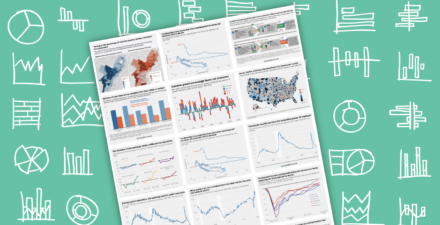Brad DeLong: Worthy reads on equitable growth, November 23-December 6, 2021
Worthy reads from Equitable Growth:
1. This monthly feature remains the best single place to go to get an immediate, timely handle on what each month’s U.S. Bureau of Labor Statistics report brings us in the way of news about the state of the U.S. labor market and the U.S. economy. The November, 2021 report, released last week, is especially puzzling. The household survey unemployment rate is down to 4.2 percent. Disappointing payroll employment growth is barely more than 200,000. Private sector employment is up. Public sector employment is down. There should not be this much divergence between a payroll survey that is close to comprehensive and a household survey that is a very good near random sample by all the standards of survey research. And yet there are these differences. They arise because even though the payroll survey is near comprehensive, it has powerful and changing biases in its failure of full comprehension. I think we badly need to spend more money figuring out exactly how these biases are evolving. Read Kathryn Zickuhr and Carmen Sanchez Cumming, “Equitable Growth’s Jobs Day Graphs: November 2021 Report Edition,” in which they write: “On December 3, the U.S. Bureau of Labor Statistics released new data on the U.S. labor market during the month of November. Below are five graphs compiled by Equitable Growth staff highlighting important trends in the data. Total nonfarm employment increased by 210,000 in November, and the employment rate for prime-age workers rose to 78.8 percent. The unemployment rate declined to 4.2 percent in November, remaining higher for Black workers (6.7 percent) and Latinx workers (5.2 percent) compared to Asian American workers (3.8 percent) and White workers (3.7 percent). The overall employment rate rose to 65.0 percent for men and 53.8 percent for women, still below pre-pandemic levels for both groups. Private-sector employment continued to make gains in November, but public-sector employment gains have faltered. Despite recent gains, the jobs recovery remains fragile. Employment in many industries has increased more slowly than in recent months, and remains below pre-pandemic levels.”
2. Many employers have decided on—and made stick—the principle that they simply do not bargain. They post a wage for the job, and then even if they get a very good match for the position, they would rather let a good worker well-matched walk than bargain over the wage with somebody who has already taken the job. This economizes on administrative effort, yes. But it has always seemed to me that it is more a matter of social power than of economic logic. One bargains with equals or neither equals. One commands those who are subordinated. Read Marta Lachowska, Alexandre Mas, Raffaele Saggio, and Stephen Woodbury, “Wage Posting or Wage Bargaining? A Tests Using Dual Jobholders,” in which they write: “This paper examines the behavior of dual jobholders to test a simple model of wage bargaining and wage posting. We estimate the sensitivity of wages and separation rates to wage shocks in a worker’s secondary job to assess the degree of bargaining versus wage posting in the labor market. We interpret the evidence within a model where workers facing hours constraints in their primary job may take a second, flexible-hours job for additional income. When a secondary job offers a sufficiently high wage, a worker either bargains with the primary employer for a wage increase or separates. The model provides a number of predictions that we test using matched employer-employee administrative data from Washington State. In the aggregate, wage bargaining appears to be a limited determinant of wage setting. The estimated wage response to improved outside options, which we interpret as bargaining, is precisely estimated, but qualitatively small. Wage posting appears to be more important than bargaining for wage determination overall, and especially in lower parts of the wage distribution.”
3. This is, I think, one of the greatest recent Equitable Growth initiatives. Take a look at “A Visual Economy. “
Worthy reads not from Equitable Growth:
1. Paul Krugman continues to remain the paragon for not just useful and applicable macroeconomic theory, not just for opening-up new literatures for research, not just for teaching students who will be future professional economists, but also for explaining what’s going on in the economy to the broad public sphere. Read his “Wonking Out: Is the Great Resignation a Great Rethink?,” in which he writes: “Unlike the “skills gap” invoked to explain persistent unemployment after the 2008 crisis, this time labor shortages seem to be real. Workers are quitting at record rates, an indication that they feel confident about finding new jobs. … So workers are clearly feeling empowered, even though many fewer Americans are employed than in the past. Why? Earlier this year many people insisted that enhanced unemployment benefits were reducing the incentive to accept jobs. But those extra benefits were eliminated. … Another story … says that the extensive aid families received during the pandemic left many … [with] the financial space to be choosier about their next job. A less upbeat story says that some employees are still afraid to go back to work, and/or that many can’t go back to work because their child care arrangements are still disrupted. But there’s at least one more possibility … the experience of the pandemic may have led many workers to explore opportunities they wouldn’t have looked at previously. … People have a strong status quo bias. … I can easily believe that there were many workers who should have quit their lousy jobs in, say, 2019, but didn’t because they weren’t really considering the alternatives. And it’s at least possible that the disruptions of the pandemic led to a great rethink …. [That] is actually a good thing—a small silver lining.”
2. This is, I think, correct. The strong balance of the evidence is still on the side of “team transitory” as far as the very moderate inflation of 2021 is concerned. If we still see moderate inflation in late 2022, come back and talk to me then about the appropriate Federal Reserve response. Read Michael Hiltzik, “There’s a right way and a wrong way to think about inflation. Here’s the right way,” in which he writes: “ There are no signs that the inflation surge showing up in the latest statistics is caused by sustained overheating of the U.S. economy. The signs point to several short-term factors coming together all at once.”



